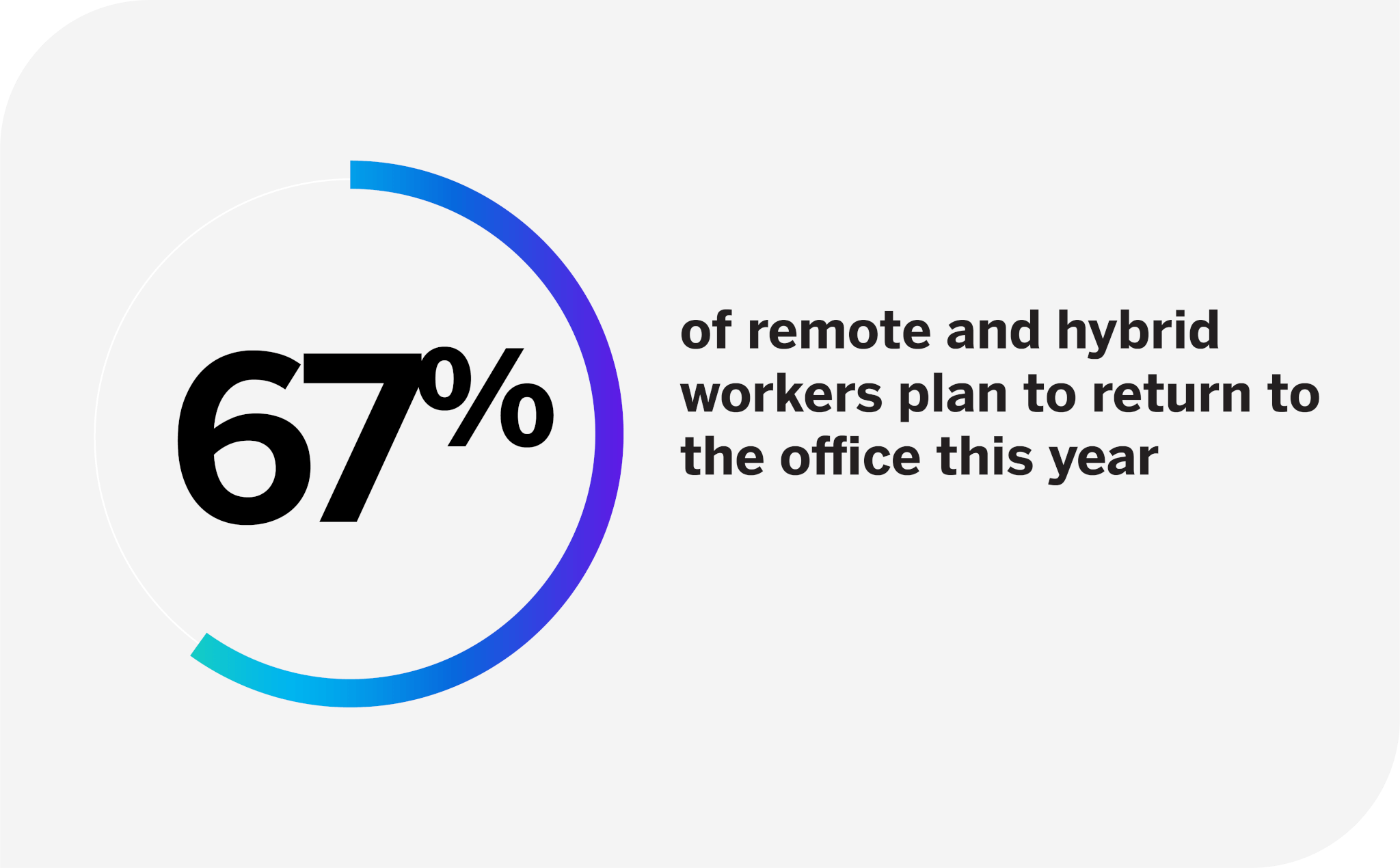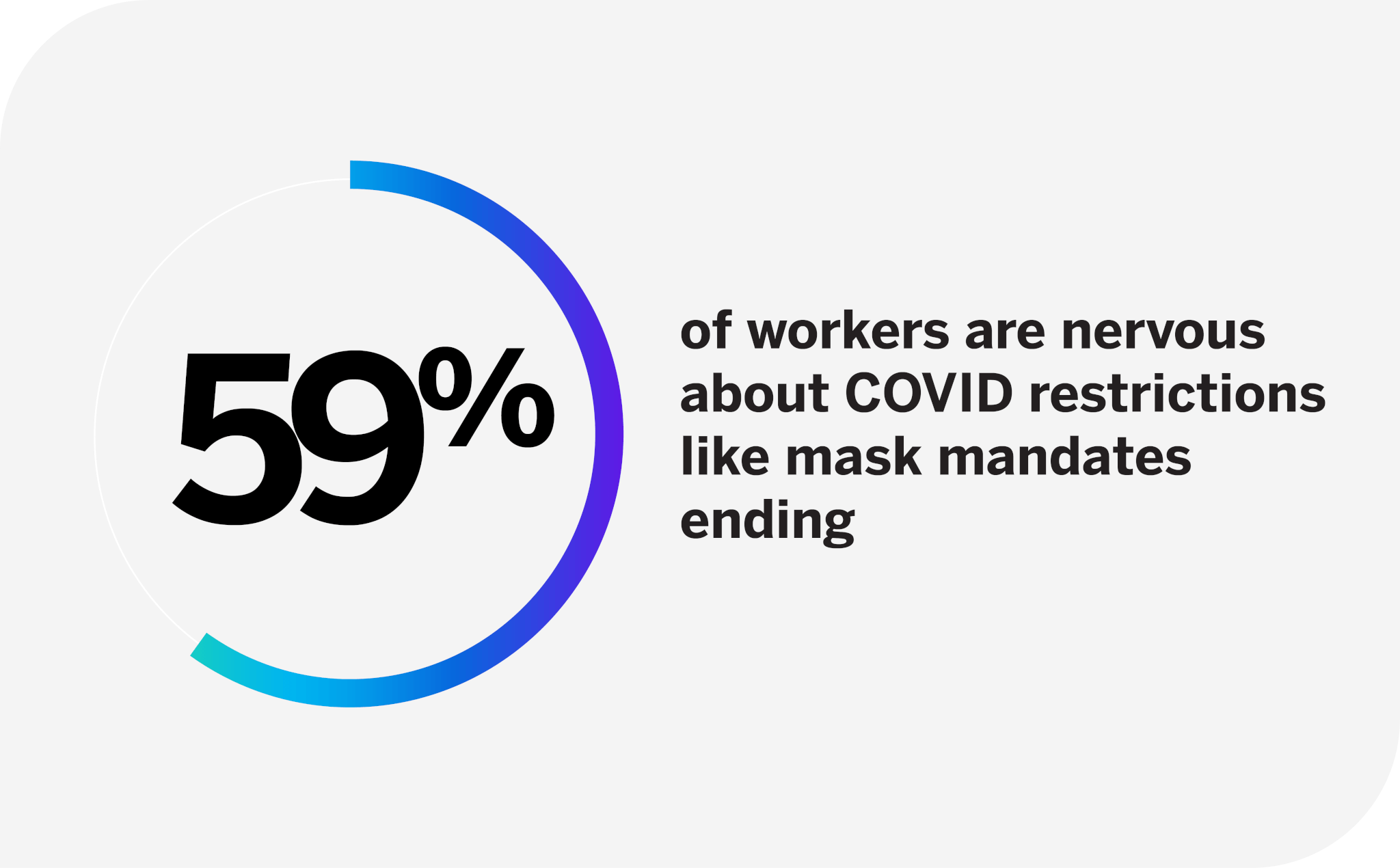Employee Experience
What’s keeping employees from going back to open offices
Businesses are bringing employees back to the office, and it’s clear that expectations have changed. While 67% of remote and hybrid workers plan on returning to the office this year, only 13% plan to go back five days a week. Two years into the pandemic, workers want more flexibility and options.
Many employees are currently able to choose whether they work remotely or in-person. Only 11% of those who have been working from home say that they don’t have the option to go into an office every day. But 60% of all U.S. workers say they are hesitant to go back to the office, and safety concerns are no longer the only thing keeping people home. Long commute times and feeling that they are more productive working from home are the top reasons employees don’t want to return to already open offices.
It’s a confusing time for COVID safety as reports of rising case counts are mixed with reports of various institutions lifting mask mandates and easing other requirements. As companies continue to plan for an eventual end to the pandemic, Qualtrics asked more than 1,000 full-time employees in the United States about their expectations for a post-pandemic workplace and what practices and policies will be appropriate.
Who’s going back to the office
Half as many women as men say they plan to return to the office five days a week, and senior leaders and managers are more likely than individual contributors to say they will go back.

- 67% of remote or hybrid workers plan to return to the office this year, but only 13% say they will go back five days a week.
- 24% plan to be in the office 3-4 days a week
- 21% plan to be in the office 1-2 days a week
- 9% will return less than once a week
- 33% don’t plan to go back to the office at all
- Only 58% of women who have been working remotely plan to go back to the office this year vs. 76% of men
- Half as many women as men (9% vs. 18%) say they will return five days a week
- Only 53% of remote or hybrid individual contributors plan to go back to the office this year vs. 80% of managers and 76% of senior leaders.
- Just 5% of individual contributors who have been working remotely will go back five days a week, compared to 18% of managers and 24% of senior leaders.
Why employees are hesitant to return to already-open offices
Only 11% of people who have been working from home say that they don’t have the option to go into an office every day. More than half (54%) of all workers say they are more productive working from home, and 79% of tech workers say the same.
- For those who currently have the option to return to the office, employees say the top reason they don’t want to go back is:
- 1) They more productive at home (17%)
- 2) They want to avoid the commute (17%)
- 3) There is no need to go into the office (15%)
- 4) They don’t want to wear a mask (8%)
- 5) No one else in the office (6%)
What’s appropriate in a post-pandemic workplace
While expectations for workplace behavior have changed drastically during COVID, most people say they will be comfortable shaking hands and sitting next to coworkers in a post-pandemic workplace.
- Most people will be comfortable with the following actions post-pandemic:
- In-person meetings (78% are comfortable), sitting next to someone (73%), shaking hands (62%), sharing supplies (55%) and large in-person gatherings (54%)
- Most people think these actions will still be inappropriate in the workplace after the pandemic is over:
- Hugs (52% are uncomfortable) and not disinfecting work stations (61% are uncomfortable)
How to convince employees to go back
While 40% of workers say they are comfortable returning to the office now, 18% say they don’t want to return to the office no matter what. The rest would return depending on COVID safety and work-life improvements.
- 25% say they would return only if everyone was vaccinated
- 15% would return only if they were paid more
- 10% would return only if the office was a better working environment
- Generations: 20% of Millennials and Gen Z don’t want to return to the office no matter what, compared to 16% of Gen X and 12% of Boomers
- For Gen Z, the number one thing that would convince them to come back to the office is being paid more
- For Millennials, Gen X and Boomers, their biggest stipulation is all workers being vaccinated
New expectations for workplace safety
More than half (56%) of all employees said in February they are nervous about returning to the office.
- 59% of workers support their employer requiring vaccines vs. 26% who do not support
- The percentage of those in support is down from 66% a year ago
- Tech workers (77%) are more likely than healthcare workers (53%) or government workers (52%) to support workplace vaccine requirements
- 59% of workers overall are nervous about COVID restrictions like mask mandates ending
- Tech workers (72%) are more nervous about restrictions like mask requirements ending than healthcare workers (48%) or government workers (55%)
- Gen Z is more nervous about restrictions ending (68%) than Millennials (64%), Gen X (54%) or Boomers (49%)
Learn more about EX
Methodology
This study was fielded between Feb. 18 and Feb. 22, 2022. Respondents were selected from a randomized panel and considered eligible if they live in the United States, are at least 18 years of age and are employed full-time. The total number of respondents was 1,050. Respondents who did not pass quality standards were removed.

